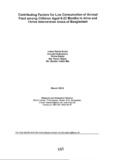| dc.contributor.author | Mukta, Umme Salma | |
| dc.contributor.author | Chakraborty, Barnali | |
| dc.contributor.author | Sayka, Umme | |
| dc.contributor.author | Haque, Md. Raisul | |
| dc.contributor.author | Mia, Md. Moslem Uddin | |
| dc.date.accessioned | 2019-12-04T09:02:47Z | |
| dc.date.available | 2019-12-04T09:02:47Z | |
| dc.date.issued | 2013-03 | |
| dc.identifier.citation | Mukta, U. S., Chakraborty, B., Sayka, U., Haque, M. R., & Mia, M. M. U. (2013, March). Contributing factors for low consumption of animal food among children aged 6-23 months in alive and thrive intervention areas of Bangladesh. Research Reports (2013): Health Studies, Vol - XLV, 88–116. | en_US |
| dc.identifier.uri | http://hdl.handle.net/10361/13193 | |
| dc.description.abstract | Introduction: In Bangladesh about two-thirds of total food consumption is rice as
main staple food, especially for the poor, in addition to some vegetables, pulses and
small quantities of fish, meat, egg, etc. if and when available. The similar dietary
pattern and practices were found for under-two children in the intervention areas of
Alive and Thrive (A& T) project where mothers were counseled on appropriate
complementary feeding practice as a component of Infant and Young Child Feeding
(IYCF). BRAG-RED intended to explore these issues to recognize the gaps that might
be addressed to increase the consumption of protein from animal foods among the
children through the IYCF interventions in A& T areas.
Objective: This study aims to identify the barriers leading to low consumption of
animal foods by children aged 6-23 months in A & T intervention areas; and to assess
their knowledge and practices of dietary intake through 24-hour recall.
Methods: Mixed methods were chosen to find comprehensive information in 12
upazi/as, 3 from each of Barguna, Sylhet, Chittagong and Dinajpur districts. The Pusti
Kormi (PK), Shasthya Shebika (SS), and mothers/caregivers enrolled in the A& T
intervention areas were selected for interview; and those who had involvement in
providing the services. In addition, other programme staff from the supervisory level
who involved in providing services was also interviewed.
Findings: The study revealed from the quantitative findings that, in intervention areas
intake from animal sources was 7 -12g at 1 years and 18g at 2 years where the
recommended dietary average (RDA) was 14g for less than one years and 16g for
less than 2 years. On the other hand in control areas at both age groups the intake
ratio was lower. From the qualitative findings majors contributing factors for feeding
from animal sources was, lack of knowledge, lack of awareness on protein deficiency,
barriers from the family members, myth, etc. Almost similar barriers was found from
the quantitative findings like; financial crisis (80.3%), mothers lack of knowledge and
awareness (67%), unavailability of the products in near local market (5%), etc.
Conclusion: Food consumption from animal sources might be increased among less
than two years children by reducing those barriers, by strengthening efforts in the
awareness development process in creating demand for appropriate IYCF services at
household level especially intake foods from animal sources to improve children's
nutritional status. | en_US |
| dc.language.iso | en | en_US |
| dc.publisher | BRAC Research and Evaluation Division (RED) | en_US |
| dc.subject | Animal food | en_US |
| dc.subject | Children | en_US |
| dc.subject | Food consumption | en_US |
| dc.subject | BRAC | en_US |
| dc.subject | Alive and thrive intervention | en_US |
| dc.subject.lcsh | Health, Nutrition, and Population Program (BRAC) | |
| dc.subject.lcsh | Children -- Nutrition -- Bangladesh. | |
| dc.title | Contributing factors for low consumption of animal food among children aged 6-23 months in alive and thrive intervention areas of Bangladesh | en_US |
| dc.type | Research report | en_US |

